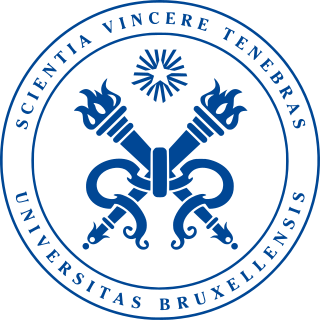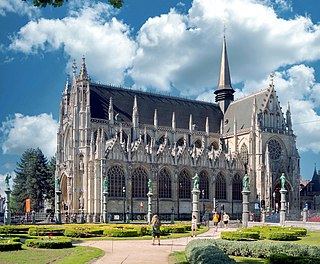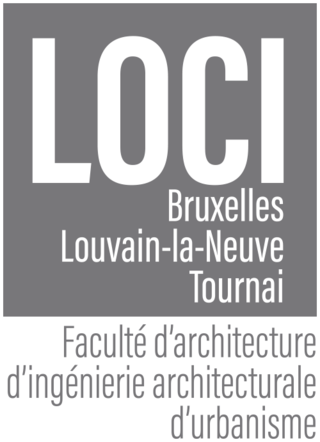Related Research Articles

Belgium, officially the Kingdom of Belgium, is a country in Northwestern Europe. The country is bordered by the Netherlands to the north, Germany to the east, Luxembourg to the southeast, France to the southwest, and the North Sea to the northwest. It covers an area of 30,689 km2 (11,849 sq mi) and has a population of more than 11.5 million, making it the 22nd most densely populated country in the world and the 6th most densely populated country in Europe, with a density of 376/km2 (970/sq mi). Belgium is part of an area known as the Low Countries, historically a somewhat larger region than the Benelux group of states, as it also included parts of northern France. The capital and largest metropolitan region is Brussels; other major cities are Antwerp, Ghent, Charleroi, Liège, Bruges, Namur, and Leuven.

Brussels, officially the Brussels-Capital Region, is a region of Belgium comprising 19 municipalities, including the City of Brussels, which is the capital of Belgium. The Brussels-Capital Region is located in the central portion of the country and is a part of both the French Community of Belgium and the Flemish Community, but is separate from the Flemish Region and the Walloon Region.

Wallonia, officially the Walloon Region, is one of the three regions of Belgium—along with Flanders and Brussels. Covering the southern portion of the country, Wallonia is primarily French-speaking. It accounts for 55% of Belgium's territory, but only a third of its population. The Walloon Region and the French Community of Belgium, which is the political entity responsible for matters related mainly to culture and education, are independent concepts, because the French Community of Belgium encompasses both Wallonia and the bilingual Brussels-Capital Region.

The Vrije Universiteit Brussel is a Dutch and English-speaking research university located in Brussels, Belgium. It has four campuses: Brussels Humanities, Science and Engineering Campus, Brussels Health Campus, Brussels Technology Campus and Brussels Photonics Campus.

The Free University of Brussels was a university in Brussels, Belgium. Founded in 1834 on the principle of "free inquiry", its founders envisaged the institution as a free-thinker reaction to the traditional dominance of Catholicism in Belgian education. The institution was avowedly secular and particularly associated with Liberal political movements during the era of pillarisation. The Free University was one of Belgium's major universities, together with the Catholic University of Leuven and the state universities of Liège and Ghent.

The Université libre de Bruxelles is a French-speaking research university in Brussels, Belgium. ULB is one of the two institutions tracing their origins to the Free University of Brussels, founded in 1834 by the lawyer and liberal politician Pierre-Théodore Verhaegen.

The Kingdom of Belgium has three official languages: Dutch (Flemish), French, and German.

Louis Marie François Franck was a Belgian lawyer and liberal politician.

UCLouvain Saint-Louis Brussels is an autonomous university campus specialized in social and human sciences part of UCLouvain and based in Brussels, Belgium.

The Francization of Brussels refers to the evolution, over the past two centuries, of this historically Dutch-speaking city into one where French has become the majority language and lingua franca. The main cause of this transition was the rapid, yet non-compulsory assimilation of the Flemish population, amplified by immigration from France and Wallonia.

In 2022, the constitution of Belgium provides for freedom of religion. The law prohibits discrimination based on religious orientation; however federal law bans face-coverings being worn in public.

The following is a timeline of the history of Brussels, Belgium.

The Sablon or Zavel is a neighbourhood and hill in the historic upper town of Brussels, Belgium. At its heart are twin squares: the larger Grand Sablon or Grote Zavel square in the north-west and the smaller Petit Sablon or Kleine Zavel square and garden in the south-east, divided by the Church of Our Blessed Lady of the Sablon. This area is served by Brussels-Chapel railway station and Brussels Central Station, as well as the tram stop Petit Sablon/Kleine Zavel.
Events in the year 1894 in Belgium.

The Marie Haps Faculty of Translation and Interpreting is a faculty of Saint-Louis University, Brussels (UCLouvain) located on its own campus in Brussels' European Quarter, in the municipalities of Ixelles and the City of Brussels. It is Belgium's oldest translation school, founded in 1955, and the fifth faculty of Saint-Louis University, Brussels, which it fully merged with in 2015.

The Faculty of Architecture, Architectural Engineering and Urban Planning, often called LOCI, is the 14th faculty of the University of Louvain, Belgium. It became an independent faculty in 2009, with the merger of three institutes founded between 1867 and 1882, and is active in Brussels (Saint-Gilles), Tournai and Louvain-la-Neuve.

Matteo Ricci College is a Mixed Catholic secondary school in Anderlecht, Brussels, Belgium. It opened in September 2019 and is a Jesuit college, the first Jesuit school to be opened in Belgium in the 21st century. It is located on Boulevard Poincaré, 400 metres north east of Brussels-South railway station.

Barbare "Varia" Kipiani was the first Georgian trained as a psychophysiologist and is recognized as a pioneering woman scholar of Georgia. Born into a noble family, Kipiani and her sisters were raised by her father after her parents' divorce. After graduating from St. Nino's School in Tbilisi in 1899, she taught in a school in Khoni for two years. Moving to Belgium, where her father had relocated, she entered the medical faculty of the Free University of Brussels in 1902. Unable to afford her tuition, Kipiani was mentored by Polish academic, Józefa Joteyko, who paid her school fees and allowed her to work in a laboratory. She wrote a paper titled "L'ergographie du sucre", which evaluated the use of sugar in alleviating fatigue. Her study won a silver medal from the Association des chimistes de France et des colonies in 1906. After completing her coursework in the medical faculty in 1907, Kipiani lectured at various universities and continued research with Joteyko on nutrition and fatigue. They jointly were awarded the Vernois Prize of the French Académie Nationale de Médecine in 1908 for their work on vegetarianism.
References
- ↑ Georgians in Belgium Retrieved on December 9, 2011.
- ↑ Georgians en Belgique on Facebook
- ↑ Mchedlishvili, David A. (2012). "ბარბარე (ვარია) ნოკოლოზის ასული ყიფიანი" [Barbara (Varia) daughter of Nikoloz Kipiani]. Members of the Society for Spreading Literacy among Georgians (in Georgian). Tbilisi, Georgia: National Parliamentary Library of Georgia. Archived from the original on 2 November 2022. Retrieved 2 November 2022.
- ↑ Despy-Meyer, Andrée (1980). Les femmes et l'enseignement supérieur : l'Université libre de Bruxelles de 1880 à 1914, Bruxelles: Université libre de Bruxelles (PDF) (Report) (in French). Brussels, Belgium: Service des archives, Université libre de Bruxelles. p. Liste des étudiantes, 45 (80 pdf). Archived (PDF) from the original on 26 November 2021.